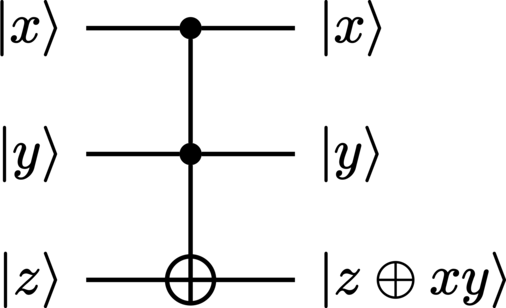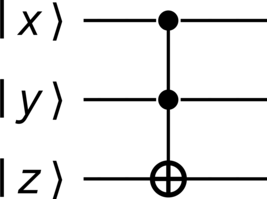CCNOT (controlled-controlled-NOT)#
Description#
A CCNOT (controlled-controlled-NOT) gate, also known as a Toffoli gate, is a simple extension to a CNOT gate (see CNOT (controlled-NOT)). It is useful as a method of multiplying the values of two qubits (e.g., \(\ket{x}\) and \(\ket{y}\)), and imprinting this result onto a third qubit (e.g., \(\ket{z}\)), e.g.,
Figure 14 visualizes this operation.


As the input states are both vectors, the action of the (linear) CCNOT gate, described by the unitary
on the tripartite input \(\ket{x} \otimes \ket{y} \otimes \ket{z}\) yields a vector state:
Table 6 is a truth table for this operation in the context of qubits.
\(x\) |
\(y\) |
\(z\) |
\(z \oplus x y\) |
|---|---|---|---|
\(0\) |
\(0\) |
\(0\) |
\(0\) |
\(1\) |
\(0\) |
\(0\) |
\(0\) |
\(0\) |
\(1\) |
\(0\) |
\(0\) |
\(1\) |
\(1\) |
\(0\) |
\(1\) |
\(0\) |
\(0\) |
\(1\) |
\(1\) |
\(1\) |
\(0\) |
\(1\) |
\(1\) |
\(0\) |
\(1\) |
\(1\) |
\(1\) |
\(1\) |
\(1\) |
\(1\) |
\(0\) |
Implementation#
from qhronology.quantum.states import VectorState
from qhronology.quantum.gates import Not
from qhronology.quantum.circuits import QuantumCircuit
# Input
first_state = VectorState(
spec=[("a", [0]), ("b", [1])],
symbols={"a": {"complex": True}, "b": {"complex": True}},
conditions=[("a*conjugate(a) + b*conjugate(b)", "1")],
label="x",
)
second_state = VectorState(
spec=[("c", [0]), ("d", [1])],
symbols={"c": {"complex": True}, "d": {"complex": True}},
conditions=[("c*conjugate(c) + d*conjugate(d)", "1")],
label="y",
)
third_state = VectorState(
spec=[("u", [0]), ("v", [1])],
symbols={"u": {"complex": True}, "v": {"complex": True}},
conditions=[("u*conjugate(u) + v*conjugate(v)", "1")],
label="z",
)
# Gate
CCN = Not(targets=[2], controls=[0, 1], num_systems=3)
# Circuit
circuit = QuantumCircuit(inputs=[first_state, second_state, third_state], gates=[CCN])
circuit.diagram()
# Output
output_state = circuit.state(label="x, y, z ⊕ xy")
# Results
first_state.print()
second_state.print()
third_state.print()
output_state.print()
Output#
Diagram#
>>> circuit.diagram()
States#
>>> first_state.print()
|x⟩ = a|0⟩ + b|1⟩
>>> second_state.print()
|y⟩ = c|0⟩ + d|1⟩
>>> third_state.print()
|z⟩ = u|0⟩ + v|1⟩
>>> output_state.print()
|x, y, z ⊕ xy⟩ = a*c*u|0,0,0⟩ + a*c*v|0,0,1⟩ + a*d*u|0,1,0⟩ + a*d*v|0,1,1⟩ + b*c*u|1,0,0⟩ + b*c*v|1,0,1⟩ + b*d*v|1,1,0⟩ + b*d*u|1,1,1⟩

